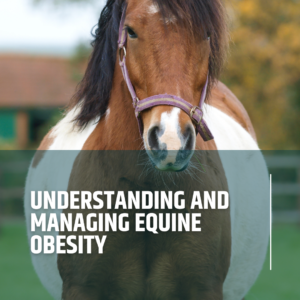Laminitis is a condition seen in animals with hooves, where there is inflammation of the lamella with ultimate failure of the suspensory apparatus of the distal phalanx. Most studies have been on horses although donkeys, goats and bovines may also be affected. Several factors appear to be involved in the development of the condition which can have both inflammatory and relatively non-inflammatory aspects. In the latter case, insulin dysregulation seems to be the driving parameter, derived either from pituitary pars intermedia dysfunction or equine metabolic syndrome. Knowles et al (2023) found that measurement of hyperinsulinaemia in the unfasted basal state or 60 minutes after corn syrup administration was predictive of the development of endocrinopathic laminitis (EL) as a systemic metabolic dysregulation. This may be mediated by the downstream effects of insulin on IGF-1R in lamellar tissues (Grenager, 2021); dysregulation of carbohydrate metabolism with formation of toxic methylglyoxal has been suggested as another route (Vercelli et al 2021). Other reports suggest that EL and laminitis are associated with alterations in glycerophospholipid and glucose metabolism (Delarocque et al 2021).
Diet may also play a role in generating an inflammatory state. Eating large amounts of new grass is known to predispose to laminitis in equines. Water-soluble carbohydrates (WSCs), particularly oligofructans (OF), are synthesised in temperate pasture grasses, particularly perennial rye grass and tall fescue (Kramer et al 2020); concentrations of WSCs increase under cool temperatures and during cooler seasons (Kagan, 2022), coinciding with peaks in the occurrence of laminitis. OFs are not readily metabolised by mammals nor are high levels of dietary starch. In both cases, there is insufficient digestion of the feed in the upper part of the intestine so that the gut contents are metabolised by bacteria in the hind gut. Several studies have shown a relationship between abnormal gut fermentation and the subsequent development of laminitis; generally Lactobacillus, Streptococcus and Enterobacteriaceae were found to be enriched in laminitic equines (Ayoub et al 2022; Garber et al 2020). Horses on a high-starch diet similarly had a greater increase in Lactobacillus (0.1% to 7.4%) and a decrease in Ruminococcaceae (11.7% to 4.2%) with increased abdominal discomfort and lameness (Bustamante et al 2022). These increases in lactic acid-synthesising bacteria, together with falls in lactic acid-utilising bacteria, mean that lactic acid levels rise, causing the gut contents to become more acidic. A metabolic inflammation then results, with generation of endotoxins (lipopolysaccharides, LPS) and increased permeability of the gut wall to exotoxins. As expected, treatment with OFs in equines caused laminitis with lower faecal pH, higher lactic acid and raised serum lipopolysaccharide (LPS) (Tuniyazi et al 2021). A similar pattern was seen in laminitic bovines (Guo et al 2021) and goats on a high starch diet (Zhang et al 2018), with an altered microbiome, raised serum lactic acid and LPS in both cases. In turn, LPS causes insulin resistance (Lebrun et al 2022; Perng et al 2022) and dysregulated glucose and phospholipid metabolism (Javaid et al 2022). LPS also increases the growth of bacterial species producing lactate (Dai et al 2020), thus reinforcing the toxic cycle. Recently, lactate in adipocytes has been suggested as mediating the development of obesity, inflammation and systemic insulin resistance ((Lin et al 2022), so providing a link between gut metabolism and the endocrine system. The mechanisms involved are certainly complex and have been discussed by Fujisaka et al (2023).
Laminitis can also be associated with sepsis as a sequel to inflammatory conditions such as colitis, diarrhoea, pneumonia or ischaemic intestinal injury which appear to generate a systemic inflammatory response syndrome (Garber et al. 2020). This probably involves local chemokine production with leukocyte migration and proliferation; digital cryotherapy and anti-inflammatory therapy are useful supportive measures (Leise and Fugler 2021). It has been suggested that given the close associations between metabolic dysregulation and laminitis with the gut bacteria, manipulating the equine microbiome would be a useful therapeutic measure (Chaucheyras-Durand et al 2022; Garber et al 2020). Potentially, dietary supplements might then be used as a preventative measure for a number of inflammatory conditions.
References
1. Ayoub C et al J Vet Int Med 36(6) 2022 2213-2223
2. Bustamante CC et al Animals 12(23): 2022 Dec 06
3. Chaucheyras-Durand F et al Microorganisms 10(12): 2022 Dec 19
4. Dai X et al Appl Env Microbiol 86(4) ,2020 02 03
5. Delarocque J et al BMC Vet Res 17(1):56, 2021 Jan 28
6. Fujisaka S et al J Endocrinol 256(3), 2023 Mar 01
7. Garber A et al J Equ Vet Sci 88:102943, 2020 May
8. Grenager NS Vet Clin N. America – Equine Practice 37(3) : 619-638 2021 Dec
9. Guo J et al Genes 12(12) 2021 12 16
10. Javaid A et al Metabolomics 18(10): 75, 2022 09 19
11. Kagan IA J Equ Vet Sci 110:103866 2022 03
12. Knowles EJ et al Equine Vet J 55(1) 2023 12-23
13. Kramer KJ et al J Equ Vet Sci 90:103014, 2020 07
14. Lebrun LJ et al Int J Mol Sci 23 (21), 2022 Oct 30
15. Leise BS and Fugler LA Vet Clin N. America – Equine Practice 37(3): 639-656 2021 Dec
16. Lin Y et al Diabetes 71(4): 637-652, 2022 04 01
17. Perng W et al J Clin Endocrinol Metab 107(7): e3018-e3028 2022 06 16
18. Tuniyazi M et al BMC Vet Res 17(1):11, 2021 Jan 06
19. Vercelli C et al PLoS ONE 16(7): e0253840 2021
20. Zhang RY et al Animal 12 (12): 2511-2520 2018 Dec





